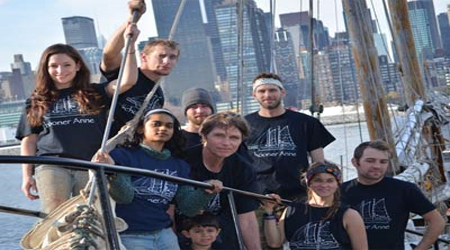I didn’t feel so good about being in a river isolated from the modern world with a stuck rudder. Georgetown might have the facilities but that meant running the gauntlet back over the mud flats, sandbars, and fishing stakes to a place that is definitely not safe for small sailboats. At night I cranked on the rudder ropes side to side. Before breakfast I tried again. The situation looked bleak. The current on the river at Parika ran strong and rough waves made getting in and out of the dinghy dangerous. When we returned from a shore excursion we had to drag the dinghy through knee deep mud to launch for the schooner.
I dove under the schooner with gloves on and felt every inch of the barnacle clad rudder where it exits the stern ten feet down to where it stood in the heavy duty shoe bolted to the bottom of the keel and didn’t discover anything wrong. At dawn I cranked on the steering lines again and suddenly we heard a noise. Then the rudder swung free again! After some time I began to think that perhaps when we were aground and bouncing on the bottom, the rudder was jammed up. Now we carry on with our broken rudder and makeshift steering lines not sure when we will ever be able to repair it properly.
Our NYC friend Capt. Dougie built a 65 ft wooden schooner in Guyana and told us about an isolated jungle town named Supanam where they build big wooden boats on the shore. We decided before our departure that Supanam would be our destination. From Parika we looked at our chart of the Essequibo river mouth. After running aground it looked daunting to try to cross 16 miles of islands, shallows and mudflats to go further into the wild. Luckily we met a man from Supanam who offered to take us across in his speed boat to show us the zig-zagging route. It was a great day. We loved the quaint hidden, protected charm of the town and the all the wooden boats perched on the river bank.
We calculated the tides and timed our trip exactly to go through the trickiest parts at high tide. What a relief it was to come in off the windblown wide river and pull into a protected deep little river. We motored slowly past the villages and all the moored junk ferry boats. Friends we were introduced to met us and showed us just where to anchor with bow and stern anchors close to the edge of the river. The leaves of a towering bamboo grove almost touched the schooner as she rested in a swift flowing jungle river.
This morning it began to rain and we quickly set our rain catchment awnings. Alex and Rachel watched one tank fill up and then they repositioned the rain tarp to flow into another tank as Darshen filled buckets from under the cockpit awning. We caught maybe a hundred gallons in two hours and about five hundred gallons by the next morning. In Georgetown, water is expensive to buy and has to go through customs before we could get it. So we opted to take a chance and catch our own water. Today we saw that would be able to take care of our fresh water needs.
This is just a very brief description of what we’ve been doing. All of the emotions, close calls, detours, and drama will be in the book we are working on.


